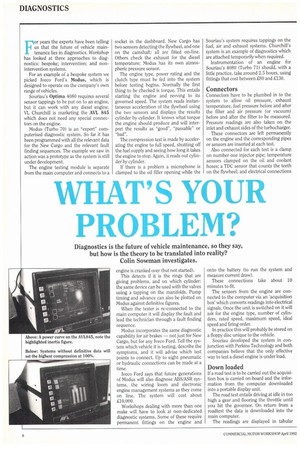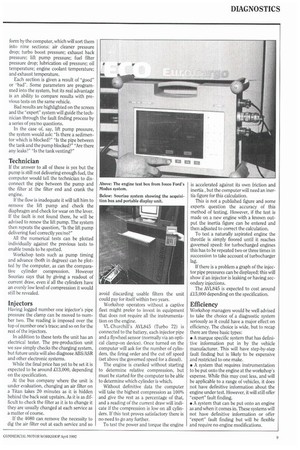WHAT'S YOUR PROBLEM?
Page 96

Page 97

If you've noticed an error in this article please click here to report it so we can fix it.
engine is cranked over (but not started).
This detects if it is the rings that are giving problems, and on which cylinder: the same device can be used with the valves using a tapping on the manifolds. Pump timing and advance can also be plotted on Modus against definitive figures.
When the tester is re-connected to the main computer it will display the fault and lead the technician through a fault finding sequence.
Modus incorporates the same diagnostic capability for air brakes — not just for New Cargo, but for any Iveco Ford. Tell the system which vehicle it is testing, describe the symptoms, and it will advise which test points to connect. Up to eight pneumatic or hydraulic connections can be made at a time.
Iveco Ford says that future generations of Modus will also diagnose ABS/ASR systems, the wiring loom and electronic engine management systems as they come on line. The system will cost about £10,000.
Workshops dealing with more than one make will have to look at non-dedicated diagnostic systems. Some of these require permanent fittings on the engine and onto the battery (to run the system and measure current draw).
These connections take about 10 minutes to fit.
The sensors from the engine are connected to the computer via an 'acquisition box' which converts readings into electrical signals. Once the unit is switched on it will ask for the engine type, number of cylinders, rated speed, maximum speed, ideal speed and firing order.
In practice this will probably be stored on a floppy disc unique to the vehicle.
Souriau developed the system in conjunction with Perkins Technology and both companies believe that the only effective way to test a diesel engine is under load.
If a road test is to be carried out the acquisition box is carried on-board and the information from the computer downloaded into a portable display unit.
The road test entails driving at idle in too high a gear and flooring the throttle until you hit the governor. On return from a roadtest the data is downloaded into the main computer.
The readings are displayed in tabular If the answer to all of these is yes but the pump is still not delivering enough fuel, the computer would tell the technician to disconnect the pipe between the pump and the filter at the filter end and crank the engine.
If the flow is inadequate it will tell him to remove the lift pump and check the diaphragm and check for wear on the lever. If the fault is not found there, he will be advised to renew the lift pump. The system then repeats the question, "Is the lift pump delivering fuel correctly yes/no?"
All the numerical tests can be plotted individually against the previous tests to enable trends to be spotted.
Workshop tests such as pump timing and advance (both in degrees) can be plotted by the computer, as can the comparative cylinder compression. However Souriau says that by giving a readout of current draw, even if all the cylinders have an evenly low level of compression it would still be revealed.
Having logged number one injector's pipe pressure the clamp can be moved to number two. The reading is imposed over the top of number one's trace; and so on for the rest of the injectors.
In addition to these tests the unit has an electrical tester. The pre-production unit we saw simply checks the charging system, but future units will also diagnose ABS/ASR and other electronic systems.
While the final price has yet to be set it is expected to be around £13,000, depending on the specification.
At the bus company where the unit is under evaluation, changing an air filter on a Titan takes 20 minutes as it is hidden behind the back seat upstairs. As it is as difficult to check the filter as it is to change it they are usually changed at each service as a matter of course.
If the 4080 can remove the necessity to dig the air filter out at each service and so avoid discarding usable filters the unit could pay for itself within two years.
Workshop operators without a captive fleet might prefer to invest in equipment that does not require all the instrumentation on the engine.
VI Churchill's AVL845 (Turbo 72) is connected to the battery, each injector pipe and a flywheel sensor (normally via an optical clamp-on device). Once turned on the computer will ask for the number of cylinders, the firing order and the cut off speed (set above the governed speed for a diesel).
The engine is cranked without starting to determine relative compression, but must be started for the computer to be able to determine which cylinder is which.
Without definitive data the computer will lake the highest compression as 100% and give the rest as a percentage of that, and a reading of the current draw will indicate if the compression is low on all cylinders. If this test proves satisfactory there is no need to go any further.
To test the power and torque the engine is accelerated against its own friction and inertia , but the computer will need an inertia figure for this calculation.
This is not a published figure and some experts question the accuracy of this method of testing. However, if the test is made on a new engine with a known output the inertia figure can be entered and then adjusted to correct the calculation.
To test a naturally aspirated engine the throttle is simply floored until it reaches governed speed: for turbocharged engines this has to be repeated two or three times in succession to take account of turbocharger lag.
If there is a problem a graph of the injector pipe pressures can be displayed; this will show if an injector is leaking or having secondary injections.
The AVL845 is expected to cost around £15,000 depending on the specification.
Workshop managers would be well advised to take the choice of a diagnostic system seriously as it could have a major effect on efficiency. The choice is wide, but to recap there are three basic types: • A marque specific system that has definitive information put in by the vehicle manufacturer. This will have step-by-step fault finding but is likely to be expensive and restricted to one make.
• A system that requires instrumentation to be put onto the engine at the workshop's expense. While this may cost less, and will be applicable to a range of vehicles, it does not have definitive information about the engine under test. However, it will still offer "expert" fault finding.
• A system that can be put onto an engine as and when it comes in. These systems will not have definitive information or offer "expert" fault finding but will be flexible and require no engine modifications.
















































































































